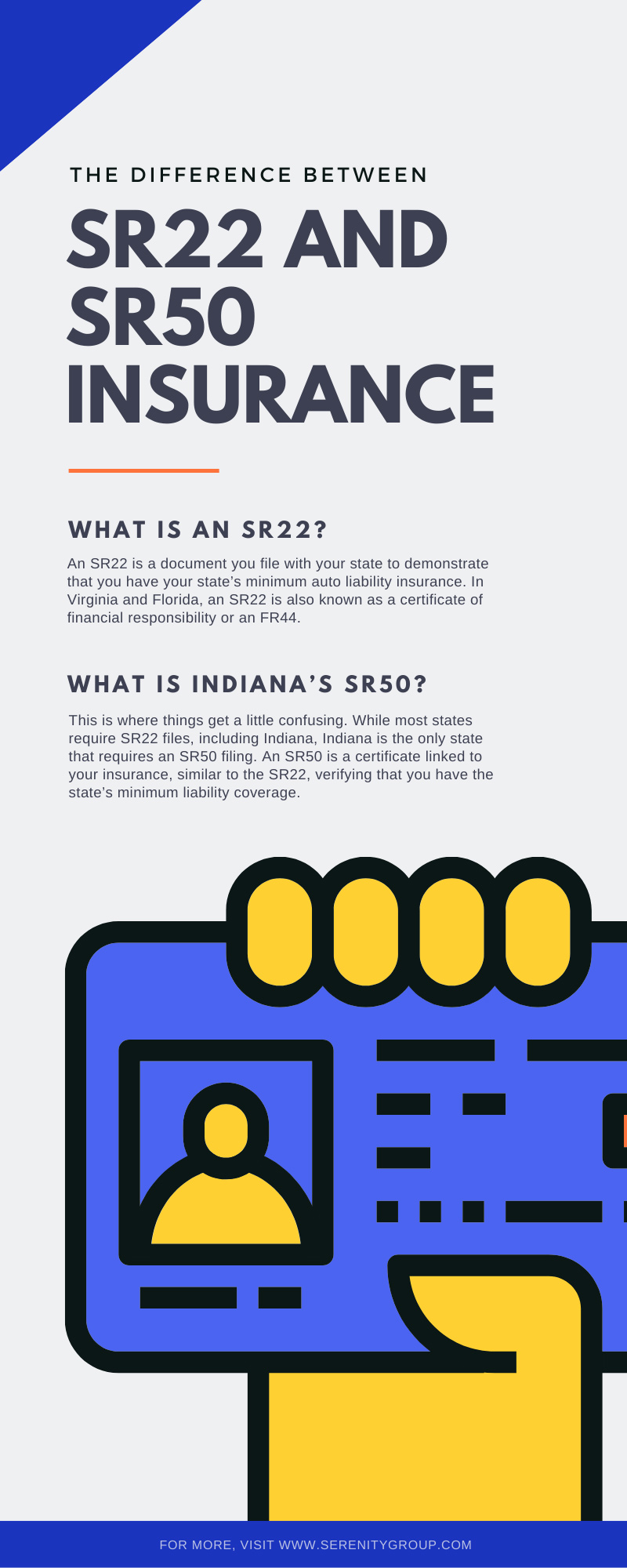The Difference Between SR22 and SR50 Insurance

Some motorists in Illinois cannot obtain affordable auto insurance because they need SR22 insurance. Many people don’t understand auto insurance, which leads to inquiries like:
- What is SR22 insurance?
- What is SR50 insurance?
- What is the difference between SR22 and SR50 insurance?
- When and why am I required to have special auto insurance?
We’ll do our best to provide answers to these questions for drivers who are eager to get back on the road. Without further delay, here are the main differences between SR22 and SR50 insurance.
What Is an SR22?
An SR22 is a document you file with your state to demonstrate that you have your state’s minimum auto liability insurance. In Virginia and Florida, an SR22 is also known as a certificate of financial responsibility or an FR44. An SR22 is a document your insurance carrier supplies that indicates you have liability coverage on your automobile insurance policy.
When Do You Need an SR22?
You must submit an SR22 when you’re required to do so by a judge or the state government. If a court requires the SR22, the judge will advise you during a hearing. The DMV will usually send you a letter if the state requires it.
Most drivers do not need to submit an SR22 with the state, but you may have to if you get pulled over without a legal license or insurance. Other reasons a motorist may be required to submit an SR22 with the state include:
- A conviction for DUI/DWI
- A conviction for driving without insurance
- Being involved in an accident without insurance
- Having too many at-fault accidents or violations
- Having to obtain a hardship or probationary license quickly
If you are looking to purchase an SR22 insurance certificate, be sure to reach out to Serenity Group today. We specialize in high-risk drivers with SR22 filings and will ensure that all your insurance work is submitted with as little trouble for you as possible!
How Do You Get an SR22?
To receive an SR22, contact your insurance company. If you already have auto insurance, you do not need new coverage. You can add the SR22 to your existing policy and have your insurer file it with the state. You will also receive a copy of the SR22 certificate.
You’ll need to acquire auto insurance if you don’t already have it, but not all companies offer SR22 coverage. Serenity Insurance can help you get SR22 insurance and will gladly walk you through the procedure. We pride ourselves on making the process as easy and as simple for you as possible. As such, we take care of all the paperwork required, leaving you to drive freely after a short filing period!
How Much Does an SR22 Cost?
A one-time SR22 filing costs roughly 25 dollars.
Unfortunately, the violation that necessitates the SR22–not the SR22 itself–will impact your insurance rates, which may go up because you’re considered a high-risk driver.
How Long Does an SR22 Last?
An SR22 certificate is valid for three years in Illinois and Indiana. Your provider must notify the state if you cancel your auto insurance while the SR22 is in place. If you cancel, the state will suspend your driving license, and you will not be able to reclaim it until you have renewed your insurance.
If I Don’t Own a Car, Do I Still Need An SR-22?
You may be required to get an SR22 certificate and SR22 auto insurance coverage even if you don’t own a car. You could still be responsible for personal injury or property damage claims if you drive a borrowed or rented vehicle and get into an accident. You might be able to get an SR22 policy as a non-owner. If your driver’s license has been suspended, you may need to obtain a non-owner SR22 to regain your driving privileges.
What Is Indiana’s SR50?
This is where things get a little confusing. While most states require SR22 files, including Indiana, Indiana is the only state that requires an SR50 filing. An SR50 is a certificate linked to your insurance, similar to the SR22, verifying that you have the state’s minimum liability coverage.
When a motorist enters Indiana, the Bureau of Motor Vehicles (BMV) must verify that the driver has the state-mandated 25/50/25 minimum liability coverage. Some instances where the BMV must verify coverage include:
- When the BMV receives an auto accident report
- When the BMV receives a moving violation within one year of receiving two other moving violations
- When a serious accident such as a misdemeanor or a felony occurs
- When a driver who was previously suspended for failing to provide proof of financial responsibility receives a moving violation
A motorist’s license may be suspended for a year if they cannot present proof of liability coverage at the time of the infraction. That driver will have to pay a reinstatement charge of between 150 and 300 dollars to reinstate their driving privileges. The BMV will also require their insurance agent to provide an SR50 form (Affidavit of Current Insurance.) In contrast, if an Indiana motorist gets convicted of certain court-related or insurance offenses, their agent may have to produce an SR22 proving liability coverage for the next three years. This is the biggest difference between the SR50 and the SR22. The SR50 certifies current liability insurance, whereas the SR22 certifies both current and future liability insurance.
We hope you have learned about the main differences between SR22 and SR50 insurance. If you want to keep your insurance rates low, it is best to avoid having an SR22 requirement. Avoid anything that forces you to choose between SR22 and SR50. However, if your do require an SR22 or SR50, you need not be concerned; simply contact your insurance company and discuss your options. Serenity Insurance specializes in many different types of insurance filings. Whether you need to file an SR22 insurance policy, a broad form insurance policy, or an FR44 policy, Serenity Group will ensure that these are filed and completed with as little trouble for you as possible!


Recent Comments